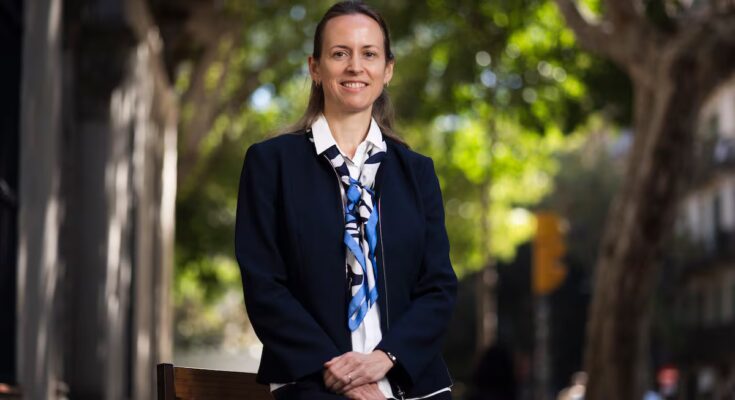Lucie Cerna has just eaten in a room at the Fundació Bofill, an institution dedicated to educational research located in a rehabilitated 19th-century factory in the L’Eixample neighborhood of Barcelona. Senior analyst of educational equity and inclusion at the OECD (a club composed mainly of developed countries), born in Prague 44 years ago, Cerna a few hours earlier had presented strategies to reduce school dropout, one of the Achilles’ heels of the Spanish education system on which her organization has advised the government in recent years.
Ask. What measures can Spain implement to reduce school dropout?
Answer. The recommendations we made to Spain included allocating more resources to vulnerable education centers and, previously, creating indicators to define which are vulnerable based on the profile of the students who attend them. Train teachers to better manage diversity and include all students. Better to distribute teachers, so that it is not especially the less experienced ones who end up in these vulnerable centres. Increase the range of professional profiles working in schools. Reduce repetition of studies, which in Spain is higher than the OECD average. Review the system of selection of educational centers by families, so that diversity is better distributed among schools. Strengthen educational orientation, so that it does not intervene only at the end of the stage, when boys and girls have to choose a career or another educational path, but rather supporting them throughout their entire educational path. And give greater flexibility to curricular itineraries, so that students can choose, among other measures, the path that best suits their needs and interests.
Q. What other professional profiles are needed in the school?
R. It is important to have, as Portugal has done, multidisciplinary teams, obviously made up of teachers, but also psychologists, educators, social workers, in some cases occupational therapists… Many fields must be covered, because school failure and dropping out do not only originate in individual learning, but have to do with personal, family, housing problems…
Q. Spain is undergoing a teacher reform and is debating whether to expand the training they receive to address diversity or focus on important traditional areas, such as teaching mathematics and language.
R. From the TALIS study (published a few weeks ago by the OECD) we know that many teachers do not consider themselves prepared to teach in a multicultural classroom, nor to teach students with special educational needs. In many countries it is not even mandatory to train in diversity; these are optional programs that prospective teachers may or may not choose. And training must cover everything. Learning to teach mathematics, yes, but also to do it to different types of students. Teaching in one class with homogeneous students is not the same as teaching in another with different learning needs. This learning must be included in initial training and also in continuing education, because it is impossible for the university to prepare them for all the scenarios they will encounter throughout their professional life.
Q. Spanish schools are also experiencing an increase in foreign students and, in parallel, an increase in child poverty. How should schools act?
Q. It is often believed that schools and teachers can solve all problems on their own, but this is not the case. There are more and more centers that offer not only teaching and learning, but also mental health services, food, etc. And the countries that are considering adopting a global and multifactorial approach. In Ireland, for example, the education system works closely with social services, housing services, employment services… To address these challenges requires deep cooperation between different actors and departments.
Q. Why is it important to reduce school socioeconomic segregation, which is high in Spain, especially between the public and subsidized school networks?
R. This is a common concern in many countries. It is important that there is a mix of social strata at school. Vulnerable students must be distributed across all schools, and greater control must be established over the school choice system, so that children from wealthy families are not concentrated in a few charter schools. There are also public centers that adopt advanced music, art or language programs and which also end up having a segregating effect, because the families who welcome the children tend to be wealthy.
Q. Why is the social class mix at school good?
R. Research shows several benefits. And it’s good in both ways. On the one hand, it creates greater social awareness and greater sensitivity towards diversity, leading to more inclusive societies. And for children who come from more humble families, it allows them to discover educational and professional paths that perhaps they had not considered, because no one had told them that these options existed.
Q. Why should Spain reduce repeat grades?
R. There are several reasons. Children who repeat themselves often feel unmotivated when they are in class with younger children, or feel as if they have failed. It also has negative economic and social consequences; Having many students repeat is very expensive. The point, above all, is that while it may work in some cases, it usually doesn’t. The student usually takes the same course without receiving support this time and the result does not improve. Repetition really became a last resort in many education systems, including other places that had very high standards, such as France. And now, in Spain, which has also seen an improvement, the regulations indicate that this must be something exceptional. It is much better to apply preventive measures. Early warning systems that warn of a student’s risk of failure and allow support to be activated quickly.
Q. Which countries perform better in terms of educational inclusion and equity?
R. Ireland, for example, is managing not only to increase its academic results, but also to improve those of less well-off students. However, this does not mean that there is no room for improvement, for example, among the Roma community. Portugal has also improved a lot. They have changed the entire education system and students receive more support and teachers receive better training to help them.
Q. What measures can Spain copy?
R. First of all, it is not possible to copy the averages, because each system is different, has a different history and structural characteristics. Ireland, for example, has created a program that allocates more resources to vulnerable schools, which could be a good option. But now they are thinking about how to help students who, without attending that type of school, are also vulnerable and need support. Allocating resources, on the other hand, is important, but even more so is thinking carefully about what to do with resources, how to prepare teachers and how to get them to work together.



